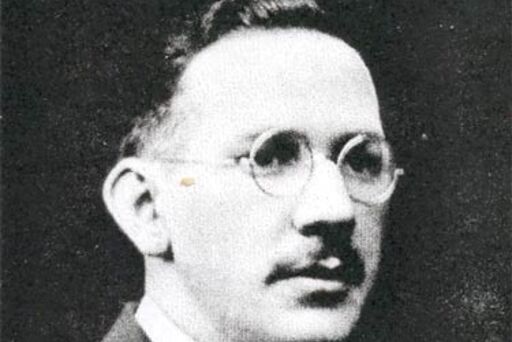The Life of Solomon Grayzel

“What Philadelphia has done to deserve Dr. Solomon Grayzel is difficult to determine, but what Dr. Grayzel has done to bring honor to this city is an open book which should be shared and appreciated first and foremost by Philadelphia Jews.” – Elazar Goelman, Dean of Gratz College
Solomon Grayzel was born in Minsk, Russia, on February 18, 1896. There, his father was one of the founders and teachers at the local heder metukan, a progressive school inspired by the nascent Zionist Movement.
He immigrated to the United States with his parents in 1906. The Grayzels settled in Brooklyn, where Solomon excelled in the public schools. Grayzel graduated from City College in 1917 and then enrolled concurrently in the Jewish Theological Seminary and Columbia University’s Department of Sociology. He spent his evenings teaching in Hebrew schools to cover his tuition, an avocation that, in time, turned into a storied vocation. Grayzel earned a master’s degree from Columbia in 1920 and was ordained at the Conservative Movement's flagship rabbinical seminary a year later.
Grayzel was a wunderkind with broad interests. Upon ordination, a group of inspired Jews in Camden, New Jersey, invited Rabbi Grayzel to serve as the first leader of the upstart Congregation Beth El. Among other factors, Grayzel was drawn to the pulpit because of its relative proximity to Dropsie College, just five miles away in Philadelphia.
At Dropsie, Solomon Grayzel unlocked a world of scholarship that had been nurtured by his parents and his teachers in New York. With a knack for languages, Grayzel focused his research on the Church and the Jews. He eagerly waded into the extant literature to explore the theological, legal, and social dimensions of Christian-Jewish relations. He received his PhD from Dropsie College in 1926.
Yet, Grayzel felt his scholarship was incomplete. He intuited that there were more sources yet to be mined. But with rabbinic responsibilities at Beth El, Grayzel could not detach himself from Camden or Philadelphia for too long. Grayzel, by this time, understood that his calling was to emerge as a public scholar for the Jewish community. He yearned for a broader reach and the skills to help him obtain that breadth.
After he defended his doctoral thesis, Grayzel resigned from Beth El and traveled to Europe to expand his research. Withal, Grayzel spent the better part of two years poring over papal letters and conciliar decrees in the Vatican archives. His trailblazing research anticipated the overwhelming interest in Jewish-Christian relations in the postwar period. The primary sources formed the basis of his 1933 tome The Church and the Jews in the 13th Century, numbering 543 pages, published by Dropsie College.
In 1928, Grayzel returned to Philadelphia and was invited to serve on the Gratz College faculty. At Gratz, he taught Jewish history and philosophy. The College also saw in Grayzel a capable administrator and tapped him to serve as registrar. In the Gratz classroom and at the nearby Young Men’s Hebrew Association, Grayzel “developed a sizable following among the students.” His friend and dean, Elazar Goelman, once said of Solomon Grayzel that “it is the rare dual faculty of speaking well and speaking to the point. To listen to Dr. Grayzel deliver an address is both an intellectual and esthetic experience, for he always has something to say, and says it eloquently.”
Solomon Grayzel was also a gifted writer with a rare capacity to reach students of all types. His History of the Jews (1947) and History of Contemporary Jews (1960) were considered staple textbooks for Hebrew school students and adult learners; and in no small way popularized the study of Jewish history in American Jewish life. Grayzel also published near-weekly columns in the local Jewish press and contributed to the burgeoning field of Jewish Studies and its attendant journals.
Gratz College could only absorb so much of Grayzel’s attention. Foremost, Grayzel married Sophie Solomon in 1932. In 1939, Grayzel assumed the editorship of the Jewish Publication Society (JPS), a positioned he flourished in for three decades.
Grayzel left his faculty post at Gratz College after 17 years of teaching. He remained connected as a member of the College’s Board of Overseers and serving as its chairman for a term. At the helm of JPS, Grayzel undertook ambitious projects. Most notably, he commissioned a new English translation of the Bible, completed in 1962. Grayzel retired from JPS in 1966. He said on occasion that the “two most important posts in this respect were my teaching at Gratz College and my service as editor of the Jewish Publication Society.”
Retirement didn’t suit the indefatigable Solomon Grayzel. He returned, although briefly, to teach at Dropsie and renewed his leadership at Gratz College, where he was awarded the Community Award at the 1967 commencement exercises.
He and Sophie, a talented educator and musician of significant repute, remained involved in Philadelphia Jewish communal affairs. Each played important roles on Philadelphia’s Federation of Jewish Agencies, Akiba Hebrew Academy, and the Philadelphia Region of the United Synagogue. On a national level, Solomon, in keeping with his commitment to public scholarship, served as president of the Jewish Book Council and recording secretary of the American Jewish Historical Society.
Solomon Grayzel died on August 12, 1980, at the age of 84, just two months after the passing of his beloved wife, Sophie.